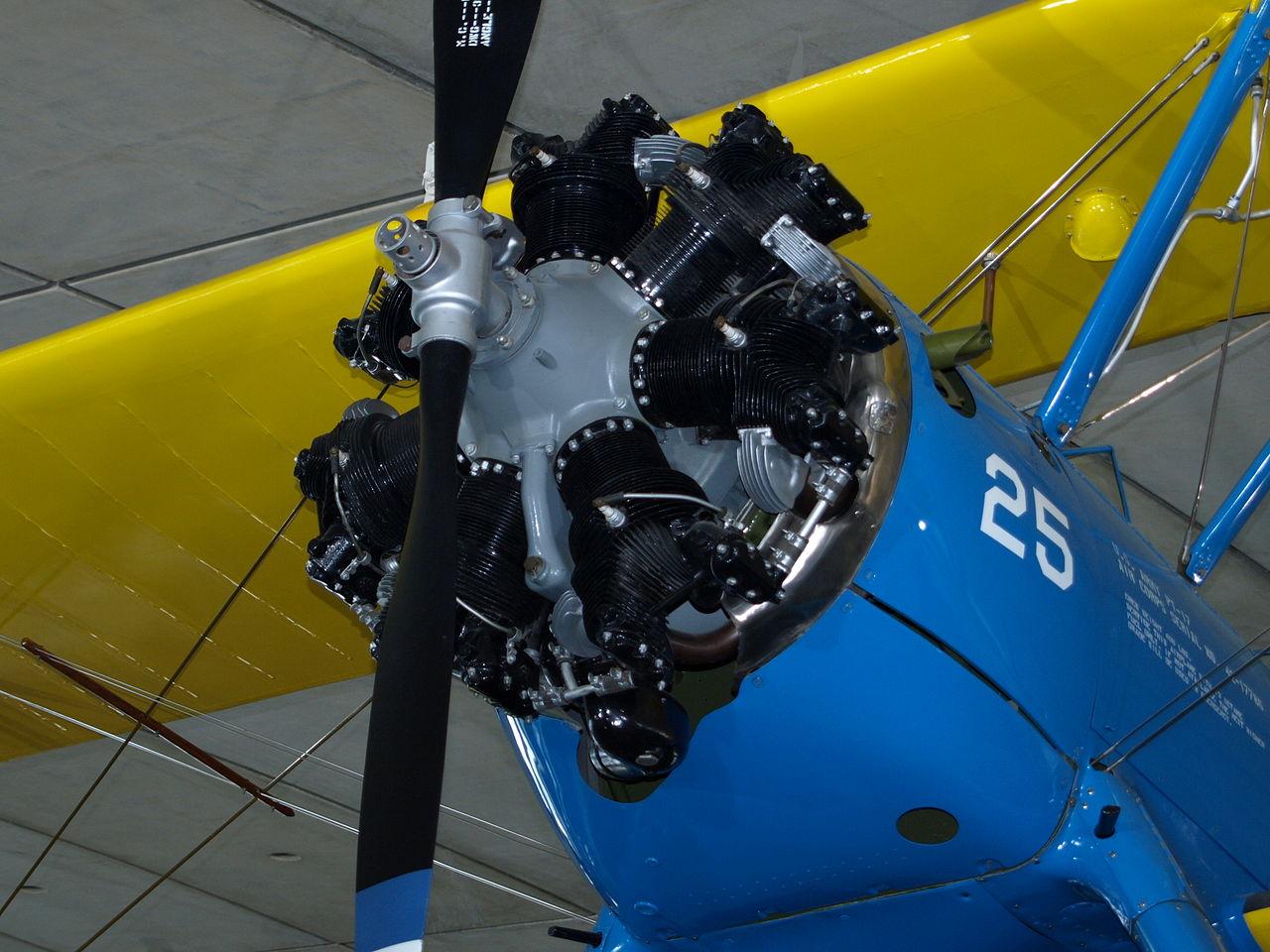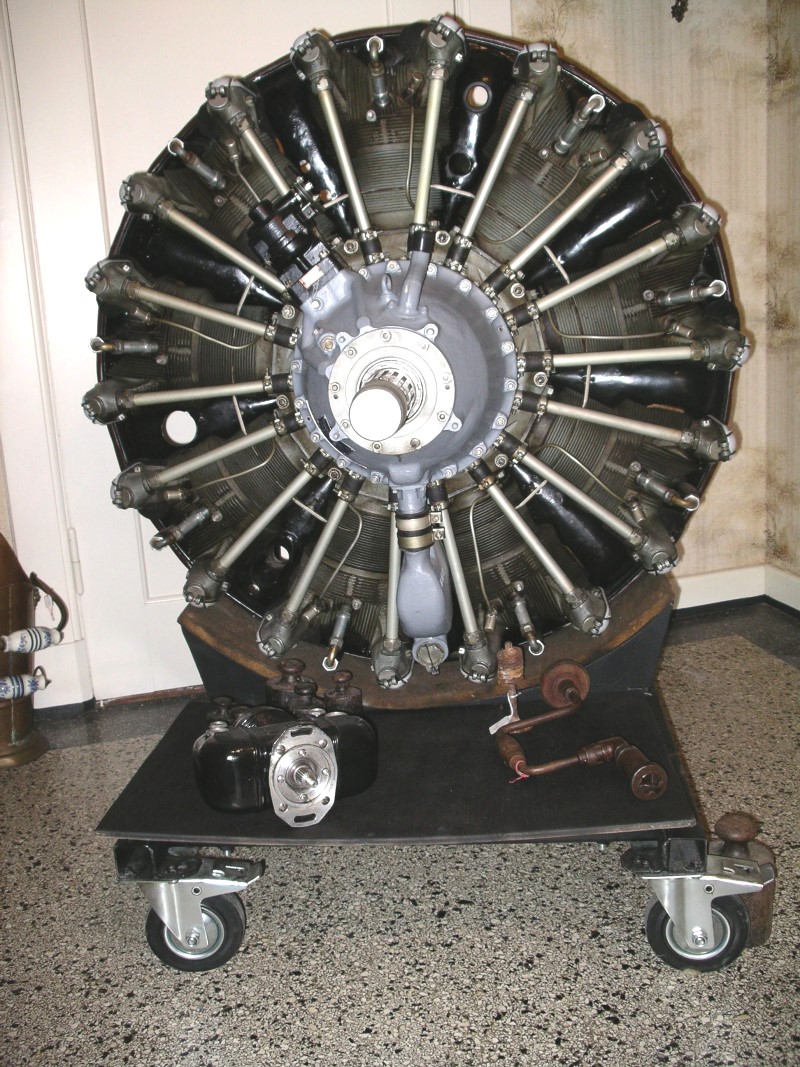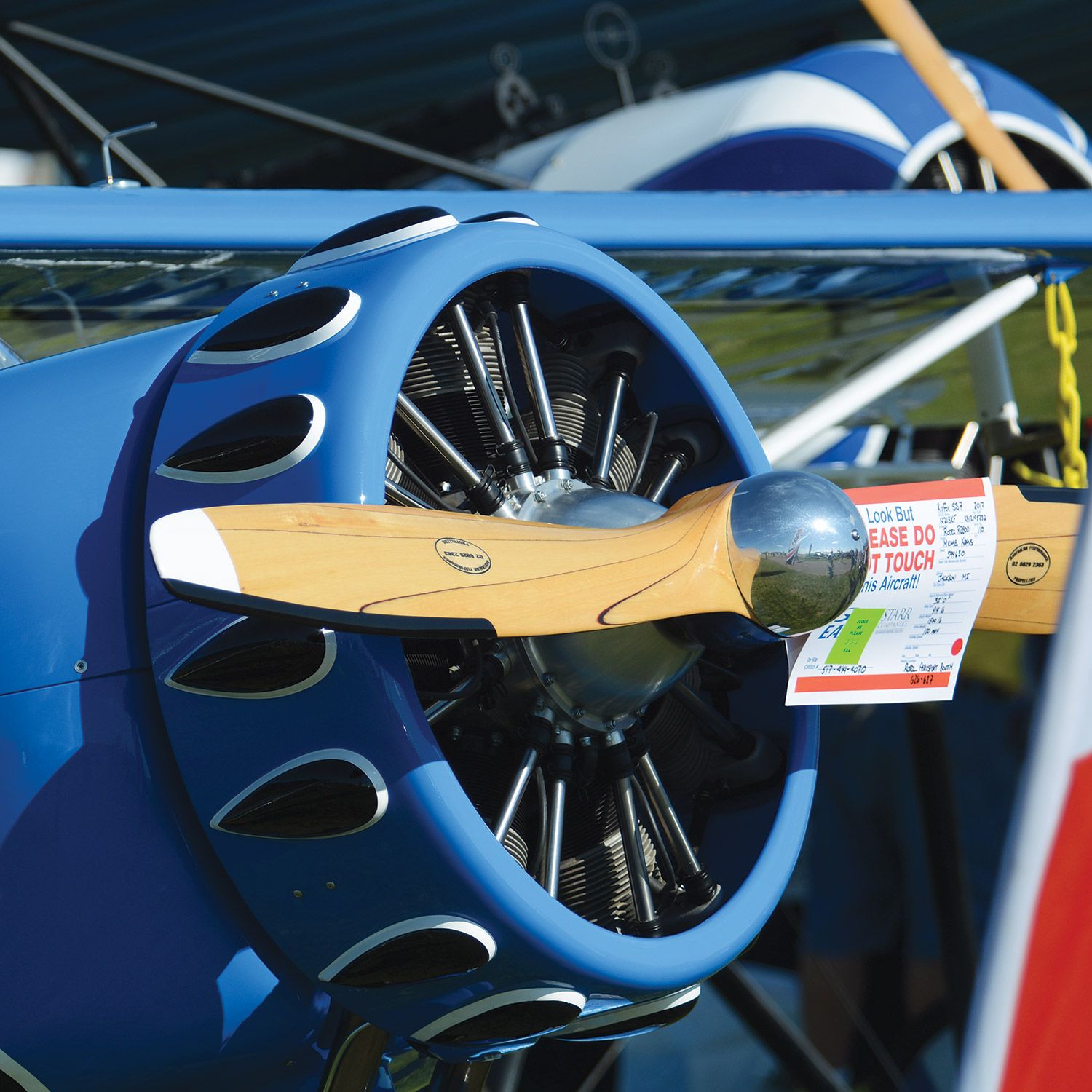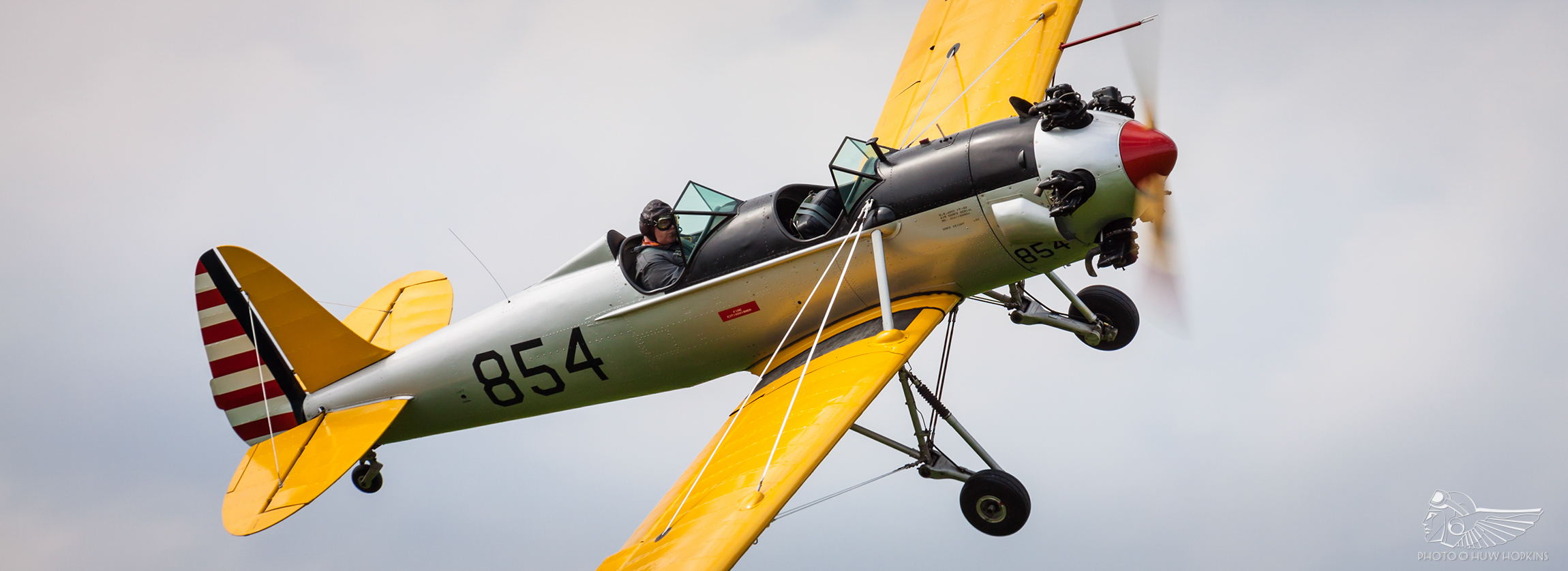Radial Engines Aircraft - Type: 3 Cylinder RadialDisplacement: 100 Cubic Inch, 1635 cc (1.63 Liter) Bore/Stroke: 92 mm x 82 mmComp Ratio: 8.2 : 1Max HP: 42 HP @ 2,500 RPMContinuous HP: 34 HP @ 2,200 RPMMax Torque: 89 Ft/Lbs
@ 2,500 RPMProp Rotation: Left-Hand, from CockpitProp Hub: 101mm Dia. x 6 holes, M8Typical Prop: Wood or Carbon, 64-74”PSRU: None, direct driveFuel Octane: 92 MoGas, 100LLDry Weight: 82 lbs (W/Electric Start), 74 lbs (no electric starter)Electric Start: Yes,
Radial Engines Aircraft

12-Volt (83 Amp)Charging: 12 Volt/28 Amp IntegratedLubrication: Phillips XC 20W60 Radial Oil Carburetor: Std - S&S Side DraftOptional: Marvel, w/ Mixture Control Optional: Dual Plug Ignition, TBI Fuel InjectionTBO: 600 Hours Type: 5 Cylinder RadialDisplacement: 207 Cubic Inch (3.4 Liter) Bore/Stroke: 92 mm x 102 mmComp Ratio: 7.8 : 1Max HP: 83 HP @ 2,300 RPMContinuous HP: 78 HP @ 1,900 RPMMax Torque: 218 Ft/Lbs @ 1,900 RPMProp.
How Does A Radial Engine Work?
Rotation: Right-Hand, from CockpitProp Hub: 101mm Dia. x 6 holes, M8Typical Prop: Wood or Carbon, 78-86”PSRU: None, direct driveFuel Octane: 92 MoGas, 100LLDry Weight: 163 lbsElectric Start: Yes, 12-Volt (83 Amp)Charging: 12 Volt/28 Amp IntegratedLubrication : Phillips XC 25W60 Radial OilCarburetor: Std - S&S Side DraftOptional: Marvel, w/ alt.
comp.Optional- Fuel InjectionTBO: 1,000 Hours A radial engine's cylinders are numbered from the top, going clockwise, with the first cylinder numbered 1. The first cylinder's connecting rod attaches directly to the crankshaft - this is the master rod.

The other cylinders' rods connect to pivoting points around the master rod. You've probably heard of a radial engine. They're the powerhouses of early aviation, up through the beginning of the jet age. These engines are amazing.
But why were they invented and how do they work? And, why did they disappear? Check it out... But radial engines do have downsides. Their massive frontal area creates drag and limits pilot visibility. Radial engines need significant airflow to cool the cylinders, so engine placement on the aircraft is limited.
Alex Udris
It's nearly impossible to install a multi-valve valve train - so nearly all radial engines use a two-valve system, limiting power. And, while a single bank of cylinders cools evenly, larger engines use rows of cylinders.
The rear rows are masked by the front rows, and the air's already hot after passing the first set of cylinders - which limits cooling. A radial engine works like any other four-stroke internal combustion engine.

Each cylinder has an intake, compression, power and exhaust stroke. They differ from inline and horizontally opposed engines in their firing order and the way they connect to the crankshaft Type: 9 Cylinder RadialDisplacement: 372 Cubic InchBore/Stroke: 92 mm x 102 mmComp Ratio: 7.8 : 1Max HP: 158 HP @ 2,400 RPMContinuous HP: 136 HP @ 2,300 RPMMax Torque: 358 Ft/Lbs @ 2,000 RPMProp Rotation: Right-Hand
, from CockpitProp Hub: SAE #1, 6 x 3/8-24 (AN-6) (Option-SAE-2)Typical Prop: Wood or Carbon, 78-86”PSRU: None, direct driveFuel Octane: 92 MoGas, 100LLDry Weight: 238 lbsElectric Start: Yes, 12-Volt (83 Amp)Charging: 12 Volt/28 Amp IntegratedLubrication: Phillips XC 25W60 Radial OilCarburetor: Std - S&S Side DraftOptional: Marvel, w/ alt.
Scarlett U
comp.Optional- Fuel InjectionTBO: 1,000 Hours You can see in the illustration that this is a five-cylinder engine -- radial engines typically have anywhere from three to nine cylinders. The radial engine has the same sort of pistons, valves and spark plugs that any four-stroke engine has.
The big difference is in the crankshaft. If you have ever seen a World War II bomber like the B-25 or the B-17, or if you have ever seen or been on an old commercial airplane like a DC-3, then you are familiar with something called a radial engine.

. Many planes of the WWII era used very large, very powerful radial engines to drive their propellers. Air-cooled radial engines have quite a few advantages over their inline cousins. They're lighter than liquid-cooled inline engines and since they don't rely on coolant, they're more damage-resistant.
Radial engines are simpler - the crankshafts are shorter and they need fewer crankshaft bearings. They're more reliable and run smoother. Aleks is a Boldmethod co-founder and technical director. He's worked in safety and operations in the airline industry, and was a flight instructor and course manager for the University of North Dakota.
Scarlett S
You can reach him at aleks@boldmethod.com. With 124 HP available, the 7S is a perfect solution to replace that expensive Rotax 912/914 with a smooth running, lightweight and more powerful 7 cylinder engine… at a much lower cost.
Eliminate costly gearbox problems and enjoy outstanding climb rates! Every radial engine has an odd number of cylinders, and they fire in an alternating order. So, a five-cylinder engine fires in a 1, 3, 5, 2, and 4 order.

A seven-cylinder engine fires in an 1, 3, 5, 7, 2, 4, 6 order. Shop Local | Contact Us | Live Chat | Order Status | RC Club *View and manage your Easy Pay payment methods, schedule and view available credit limit within the "Easy Pay" section of My Account.
*Easy Pay financing option is available at Horizon's sole discretion and terms are subject to change. Ultimately, the turbine and turboprop engines developed after World War II could develop much more power than a radial engine, more efficiently and with less weight.
Turbines Stole The Market
But it doesn't change the fact that radial engines look cool, and sound even better. Imagine up front… a growling 372 cubic inch, 9-cylinder radial, straight exhaust, swinging a huge prop with 358 ft/lbs of torque;
giving you the power of a 4-cylinder Lycoming 0-320, with the weight of a dressed Lycoming O-235. Radial engines reached their zenith during WWII. There are some radial engines around today, but they are not that common.

Most propeller-driven planes today use more traditional engine configurations (like a flat four-cylinder) or modern gas turbine engines. Gas turbines are much lighter than radial engines for the power they produce. To get more power out of a radial engine, engineers added multiple rows of cylinders.
The Pratt & Whitney Wasp Major uses four rows of seven cylinders (that's 28 total cylinders!) with a supercharger to generate up to 4,300 horsepower. It powered many of the last piston-powered large aircraft, including the B-36 Peacemaker (which used six Wasp Majors and four turbojets) and the Martin Mars.
Instead of the long shaft that's used in a multi-cylinder car engine, there is a single hub -- all of the piston's connecting rods connect to this hub. One rod is fixed, and it is generally known as the master rod.
The others are called articulating rods. They mount on pins that allow them to rotate as the crankshaft and the pistons move. Type: 7 Cylinder RadialDisplacement: 290 Cubic Inch (4.7 Liter) Bore/Stroke: 92 mm x 102 mmComp Ratio: 7.8 : 1Max HP: 124 HP @ 2,300 RPMContinuous HP: 103 HP @ 2,000 RPMMax Torque: 288 Ft/Lbs @ 2,000 RPMProp.
Rotation: Right-Hand, from CockpitProp Hub: 101mm Dia. x (6 x M8) (Option - SAE #1, 6 x AN-6)Typical Prop: Wood or Carbon, 78-86”PSRU: None, direct driveFuel Octane: 92 MoGas, 100LLDry Weight: 183 lbsElectric Start: Yes, 12-Volt (83 Amp)Charging: 12 Volt/28 Amp IntegratedLubrication: Phillips XC 25W60 Radial OilCarburetor: Std - S&S Side DraftOptional: Marvel, w/ alt.
comp.Optional- Fuel InjectionTBO: 1,000 Hours Type: 5 Cylinder RadialDisplacement: 166 Cubic Inch (2.7 Liter) Bore/Stroke: 92 mm x 102 mmComp Ratio: 8.2 : 1Max HP: 60 HP @ 2,300 RPMContinuous HP: 45 HP @ 2,000 RPMMax Torque: 133 Ft/Lbs @ 2,200 RPMProp.
Rotation: Right-Hand, (CW) from CockpitProp Hub: 101mm Dia. x 6 holes, M8Typical Prop: Wood or Carbon, 65-75”PSRU: None, direct driveFuel Octane: 92 MoGas, 100LLDry Weight: 119 lbsElectric Start: Yes, 12-Volt (83 Amp)Charging: 12 Volt/28 Amp IntegratedLubrication
: Phillips XC 25W60 Radial OilCarburetor: Std - S&S Side DraftOptional: Marvel, w/ alt. compensation, TBI Fuel InjectionOptional- Dual-Plug Electronic IgnitionTBO: 600 Hours
radial engine for sale, radial aircraft engine manufacturers, new radial aircraft engines, modern radial aircraft engines, largest radial aircraft engine, radial aircraft engine diagram, radial aircraft engine model kits, radial aircraft engine startup videos